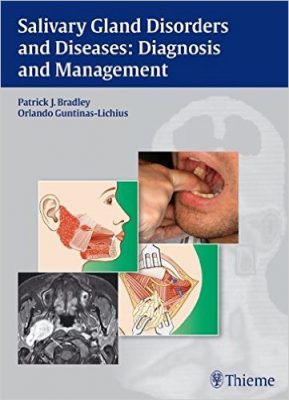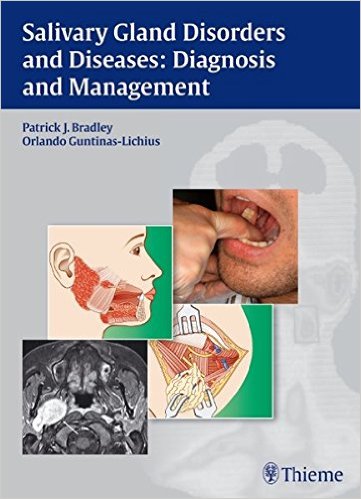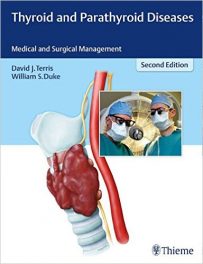 Editors: Patrick J. Bradley, MBA, and Orlando Guntinas-Lichius, MD
Editors: Patrick J. Bradley, MBA, and Orlando Guntinas-Lichius, MD
Publisher: Thieme – 486 pages, with 372 illustrations
Book Review by: Nano Khilnani
There are few medical texts out there that focus on salivary glands, and this is one with broad scope and in-depth detail as well. There is so much to be learned from this book that only specialists know. This review will provide you basically an overview of the content you will find in the book, so you can acquire it and place it on your book shelf as a reference.
“The salivary system is a small universe to itself,” writes Dr. Eberhard Stennert in the Foreword to this book. He points out that salivary glands are challenged by many conditions – organic, hormonal, and inflammatory, as well as benign or malignant tumors.
He writes that the World Health Organization has identified the parotid gland – one of the salivary glands in the human body – as being affected by as many as 43 tumors, 15 of which are benign, but 28 are malignant. The latter consists of 24 types of malignant epithelial tumors, three types of hematolymphoid tumors, and one type of soft-tissue tumor.
With 28 malignant tumors and 15 benign ones, he points out: “It is all the more surprising that until recently there was little awareness among clinicians of the importance of salivary gland diseases. One explanation may be that these diseases are comparatively rare.” Some of the tumors, if not found early could become life threatening.
“A woeful lack of knowledge about them has often led to inappropriate medical treatment, with sometimes fatal consequences,” Dr. Stennert asserts. On the bright side, evidence-based treatment has significantly taken over “the way I do it” stance in approaching salivary gland diseases, multidisciplinary collaboration has begun, and many other positive developments have happened in this specialty, including the introduction of sialendoscopy as a means of diagnosis.
The editors – Dr. Patrick Bradley and Dr. Orlando Guntinas-Lichius – also importantly inform us in the Preface: “Tremendous advances have been made in diagnostic methods, with cystopathology, histopathology, biochemistry, and imaging.” They point out by using the sialendoscope, various diseases have been detected, and it has been possible to preserve many more salivary glands than before.
Fifty-two contributors from 12 countries – Austria, Belgium, Czech Republic, France, Germany, Italy, Sweden, Switzerland, the Netherlands, Norway, the United Kingdom, and the United States – authored the 46 chapters of this unusual book. The chapters are allocated among six Sections, namely:
- Section I – Salivary Glands – Anatomy and Evaluation
- Section II – Pediatric Disorders
- Section III – Physiological Disorders
- Section IV – Benign Salivary Gland Neoplasms
- Section V – Malignant Salivary Gland Neoplasms
- Section VI – Other Topics
Within these six Sections, the 46 chapters in this book cover a large number and range of abnormalities, conditions, diseases, and disorders (including neoplasms and non-neoplastic situations) that affect or adversely impact upon the group of salivary glands, ducts, the tongue, lymph nodes, muscles, and other elements in the human oral system. These particularly include the pair of parotid glands, the parotid duct, the accessory parotid gland, the ducts of Rivinus, the Stenson duct, the Wharton duct, the sublingual gland, and the submandibular gland.
Section I chapters include those that discuss the clinical anatomy of the salivary glands and associated oral system components, their functions and regulatory mechanisms, evaluation and pathology of saliva, methods of investigation for disease identification, and patient’s medical history, imaging, fine-needle aspiration cytology, and diagnostic sialendoscopy.
Section II chapters on pediatric disorders cover congenital and developmental abnormalities, salivary gland neoplasms, drooling, and inflammatory and infectious diseases of the salivary glands.
Section III chapters on physiological disorders discuss topics such as dry mouth and dry eyes, sialadenitis and sialadenosis, and interventional sialendoscopy, autoimmune disorders, lymphoproliferation, granulomatous inflammation, and cystic salivary gland tumors including cystic neoplasms.
Section IV chapters on benign salivary gland neoplasms cover topics such as their epidemiology, etiology, classification, and investigation, as well as surgical management, radiotherapy, and recurrent benign salivary tumors.
Section V is about malignant salivary gland neoplasms, and its chapters cover the same aspects of this type of diseases – epidemiology, etiology, classification, investigation, surgical management, and radiotherapy. In addition, there are chapters in this Section on chemotherapy and novel therapeutics, neck metastasis, locoregional recurrence, distant metastases, and a final chapter on prognostic index for overall disease control in patients with parotid carcinoma.
Section VI has chapters on a number of different topics including malignant head and neck tumors and skin cancer infiltrating the parotid glands, principles of facial reanimation surgery, morbidity of treatments, trauma-induced problems in the salivary glands, the influences of chemotherapy and radiotherapy, salivary gland transplantation, and new developments in molecular biology.
This is an excellent, well organized and extensive book, with detailed discussions and numerous illustrations on the large number and range of diseases of the salivary glands that are not commonly known, with guidance on current diagnostic and therapeutic treatment, and surgery.
Containing material contributed by more than 50 experts from a dozen countries, this book presents up-to-date knowledge on numerous aspects of this field, including new research findings from biochemistry, cell studies, histopathology, imaging, and molecular biology; and the latest advances in medical and surgical management.
Editors:
Patrick J. Bradley, MBA, FCRCS, FACS, FRACS (Hon), FRCSLT (Hon) is Past President of the European Salivary Gland Society; Professor Emeritus of Head and Neck Oncologic Surgery in the Department of ORL-HNS at Nottingham Hospitals in Queens Medical Center Campus in Nottingham, United Kingdom.
Orlando Guntinas-Lichius, MD is Professor and Chairman of the Department of Otorhinolaryngology in the Institute of Phoniatry / Pedaudiology in Frederich-Schiller University Jena in Jena, Germany.
Foreword:
Eberhard Stennert, Emeritus Professor in Jean Uhrmacher Institute at University of Cologne in Cologne, Germany.







